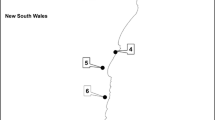Abstract
The raccoon dog Nyctereutes procyonoides, an East Asian canid species, was introduced into the European part of the former USSR since 1928. Within 50 years (1935–1984), it colonised a territory of 1.4 million km2 in Europe. A telemetry study took place in Southern Brandenburg in a 60 km2 sized study area with a typical mosaic structured East German agricultural landscape. For catching raccoon dogs, 20 trap boxes were set there in an area of 46 km2, and between February 2001 and July 2004, 15 (5 males, 10 females) adult and 46 (25 males, 21 females) juvenile raccoon dogs were eartagged and adults additionally fitted with radio collars (Biotrack, 150–151 MHz). Data on dispersal behaviour was collected by the relocation points of 11 juveniles (6 males, 5 females). Four juvenile males dispersed even more than 40 km from their trapping places. Additionally, dispersal of two adult males could be documented. This behaviour probably indicates that the German raccoon dog population still is in a process of colonising. This canid’s ability for colonising spacious and distant areas during comparative short periods of time and its preference for habitats with richness of water possibly make this species to be an important vector of fox tapeworm Echinococcus multilocularis—a very dangerous zoonosis.

Similar content being viewed by others
References
Ansorge H (1998) Biologische Daten des Marderhundes aus der Oberlausitz. Abh Ber Naturkundemus Görlitz 70:47–61
Barbu P (1972) Beiträge zum Studium des Marderhundes Nyctereutes procyonoides ussuriensis Matschie, 1907, aus dem Donaudelta. Säugetierk Mitt 20:375–405
Bögelsack K (2003) Habitatnutzung und Dismigration juveniler Marderhunde (Nyctereutes procyonoides GRAY, 1834) in Nordostdeutschland. Diplomarbeit an der Fachhochschule Eberswalde
Caughly G, Sinclair ARE (1994) Wildlife ecology and management. Blackwell, Boston
Drygala F, Mix H, Stier N, Roth M (2000) Preliminary findings from ecological studies of the racoon dog (Nyctereutes procyonoides) in eastern Germany. Z Ökologie u Naturschutz 9:147–152
Holmala K, Kauhala K (2006) Ecology of wildlife rabies in Europe. Mammal Rev 36:17–36
Judin VG (1977) Marderhund in Primorje und Amur-Gebiet. Verlag “Nauka”. Moskau (in Russian)
Kauhala K, Helle E (1994) Home ranges and monogamy of the raccoon dog in southern Finland. Suomen Riista 40:32–41 (in Finnish with English summary)
Kauhala K, Helle E, Taskinen K (1993) Home range of the raccoon dog (Nyctereutes procyonoides) in southern Finland. J Zool London 231:95–106
Kenward R (1993) Wildlife radio tagging–equipment, field techniques and data analysis, 3rd edn. Auflage University Press, Cambridge
MacDonald D, Sillero-Zubiri C (2004) The biology and conservation of wild canids, 1st edn. Auflage, University Press, Oxford
McNeely JA (2000) Global strategy for addressing the problem of invasive alien species, first draft of the GISP Global Strategy on Invasive Alien Species. IUCN, Gland, Switzerland
Möckel R (2000) Der Marderhund in der Niederlausitz. Naturschutz und Landschaftspflege in Brandenburg 9:19–22
Nowak E (1973) Ansiedlung und Ausbreitung des Marderhundes (Nyctereutes procyonoides GRAY) in Europa. Beitr zur Jagd- und Wildforschung 8:351–384
Nowak E (1993) Nyctereutes procyonoides (Gray,1834)—Marderhund. In: Stubbe M, Krapp F (eds) Handbuch der Säugetiere Europas, vol 5/1. Aula Verlag, Wiesbaden, pp 215–248
Pielowski Z (1994) Zur Situation des Marderhundes (Nyctereutes procyonoides) in Polen. Beiträge zur Jagd- und Wildforschung 19:185–187
Sackl P (2001) Der Marderhund Nyctereutes procyonoides(Gray, 1834). In: Spitzenberger F (ed) Die Säugetierfauna Österreichs. AMS-Verlag, Graz
Schwarz S, Sutor A, Pitra C (2004) Raccoon dogs–silently colonizing Europe (Nyctereutes procyonoides GRAY 1834). Proceedings volume, Neobiota Conference Bern
Tackmann K, Goretzki J, Sutor A, Schwarz S, Conraths FJ (2005) Der Marderhund (Nyctereutes procyonoides) als neuer Endwirt für Echinococcus multilocularis in Ostdeutschland—erste Ergebnisse einer Studie in Brandenburg. Beitr zur Jagd- und Wildforschung 30:323–330
Thiess A (2004) Untersuchungen zur Helminthenfauna und zum Vorkommen von Trichinella sp. Beim Marderhund (Nyctereutes procyonoides) in Brandenburg. Dissertation, Freie Universität Berlin
Wandeler A, Lüps P (1993) Vulpes vulpes (Linnaeus,1758)—Rotfuchs. In: Stubbe M, Krapp F (eds) Handbuch der Säugetiere Europas, vol 5/1. Aula Verlag, Wiesbaden, pp 139–193
Westerling B (1991) Rabies in Finland and its control 1988–90. Suomen Riista 37:93–100 (in Finnish with English summary)
White GC, Garrott RA (1990) Analysis of wildlife radio-tracking data. Academic, San Diego, California
Acknowledgements
This study is part of a 4-year telemetry project on raccoon dogs supported by the following organisations: CIC Internationaler Jagdrat zum Schutz des Wildes, Zoologische Gesellschaft Frankfurt, DBU Deutsche Bundesstiftung Umwelt, Förderverein Großtrappenschutz e.V. and the Landesveterinäramt Brandenburg. Thanks to my scientific supervisor Prof. Dr. Ilse Storch, Albert-Ludwigs-University of Freiburg, Department of Wildlife Ecology and Management. Particularly, I am very grateful to Dr. Kaarina Kauhala for her constructive comments and critical review of the manuscript and for providing the map to my colleague Sabine Schwarz. I also would like to thank the Friedrich-Löffler-Institut Wusterhausen and the SVLA Frankfurt/Oder for veterinary analysis. To all hunters who enabled this telemetry project and to those who give me information about migrated eartagged and radio-collared animals, I am thankful for their support. Performed experiments comply with current German laws.
Author information
Authors and Affiliations
Corresponding author
Additional information
Communicated by W. Lutz
Rights and permissions
About this article
Cite this article
Sutor, A. Dispersal of the alien raccoon dog Nyctereutes procyonoides in Southern Brandenburg, Germany. Eur J Wildl Res 54, 321–326 (2008). https://doi.org/10.1007/s10344-007-0153-8
Received:
Revised:
Accepted:
Published:
Issue Date:
DOI: https://doi.org/10.1007/s10344-007-0153-8




